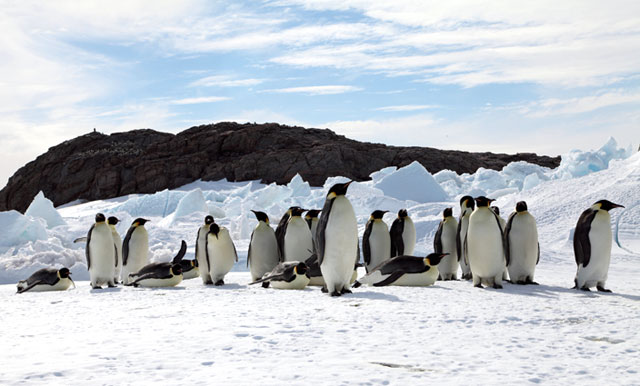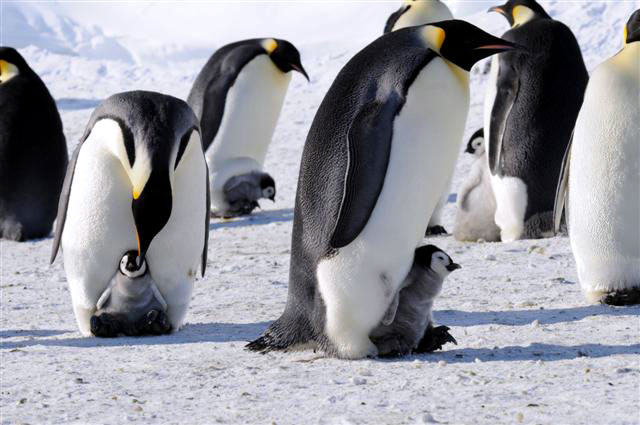
Photo Credit: Stephanie Jenouvrier/WHOI |
A group of emperor penguin
adults make their way across sea ice in Terre Adélie in East Antarctica.
The seabirds rely on sea ice for breeding and raising their young, but
declines in sea ice from warmer temperature may be affecting the colony,
according to new research. |
Disappearing act
Sea ice linked to decline of emperor penguin colony in East Antarctica
From staff reports
Posted July 6, 2012
If global temperatures continue to rise, an emperor penguin
colony in Terre Adélie in East Antarctica may eventually disappear,
according to a new study led by researchers from the
Woods Hole Oceanographic Institution (WHOI) 
. The study was published in the June 20 edition of the journal
Global Change Biology.
“Over the last century, we have already observed the
disappearance of the Dion Islets penguin colony, close to the Antarctic
Peninsula,” said
Stephanie Jenouvrier 
, WHOI biologist and lead author of the new study, in a
press release from WHOI 
. “In
1948 and the 1970s, scientists recorded more than 150 breeding pairs
there. By 1999, the population was down to just 20 pairs, and in 2009,
it had vanished entirely.”
Jenouvrier thinks the decline of the penguins in both
locations might be connected to a simultaneous decline in Antarctic sea
ice due to warming temperatures in the region.
Unlike other sea birds, emperor penguins breed and raise
their young almost exclusively on sea ice. If that ice breaks up and
disappears early in the breeding season, massive breeding failure may
occur, according to Jenouvrier.
“As it is, there’s a huge mortality rate just at the
breeding stages, because only 50 percent of chicks survive to the end of
the breeding season, and then only half of those fledglings survive
until the next year,” she said.
Disappearing sea ice may also affect the penguins’ food
source. The birds feed primarily on fish, squid and shrimplike krill,
which in turn feeds on zooplankton and phytoplankton, tiny organisms
that grow on the underside of the ice. If the ice goes, Jenouvrier said,
so too will the plankton, causing a ripple effect through the food web
that may starve the various species that penguins rely on as prey.

Emperor penguins and chicks from a different colony in the Ross Sea region.
To project how penguin populations may fare in the future,
Jenouvrier’s team used data from several different sources, including
climate models, sea ice forecasts, and a demographic model that
Jenouvrier created of the emperor penguin population at Terre Adélie, a
coastal region of Antarctica where French scientists have conducted
penguin observations for more than 50 years.
Combining this type of long-term population data with information on climate was key element to the study, said
Hal Caswell 
, a WHOI senior mathematical biologist and collaborator on the paper whose research on the project was funded by the
National Science Foundation 
.
“If you want to study the effects of climate on a
particular species, there are three pieces that you have to put
together,” he said. “The first is a description of the entire life cycle
of the organism, and how individuals move through that life cycle. The
second piece is how the cycle is affected by climate variables. And the
crucial third piece is a prediction of what those variables may look
like in the future, which involves collaboration with climate
scientists.”
Marika Holland 
of the
National Center for Atmospheric Research (NCAR) 
is one such scientist. She specializes in studying the relationship
between sea ice and global climate, and she helped the team identify
climate models for use in the study.
Working with
Julienne Stroeve 
, another sea ice specialist from the National
Snow and Ice Data Center (NSIDC) 
, Holland ultimately recommended five distinct models.

Photo Credit: Stephanie Jenouvrier/WHOI
Emperor penguins breed and raise
their young almost exclusively on sea ice, which is shrinking in some
areas around Antarctica from climate change.
“We picked the models based on how well they calculated the
sea ice cover for the 20th century,” she says. “If a model predicted an
outcome that matched what was actually observed, we felt it was likely
that its projections of sea ice change in the future could be trusted.”
Jenouvrier used the output from these various climate
models to determine how changes in temperature and sea ice might affect
the emperor penguin population at Terre Adélie. She found that if
greenhouse gas emissions continue to rise at levels similar to today —
causing temperatures to rise and Antarctic sea ice to shrink — penguin
population numbers will diminish slowly until about 2040, after which
they would decline at a much steeper rate as sea ice coverage drops
below a usable threshold.
Best projections show roughly 500 to 600 breeding pairs
remaining by the year 2100. Today, the population size is around 3,000
breeding pairs.
The effect of rising temperature in the Antarctic isn’t
just a penguin problem, according to Caswell. As sea ice coverage
continues to shrink, the resulting changes in the Antarctic marine
environment will affect other species, and may affect humans as well.
“We rely on the functioning of those ecosystems. We eat
fish that come from the Antarctic. We rely on nutrient cycles that
involve species in the oceans all over the world,” he said.
“Understanding the effects of climate change on predators at the top of
marine food chains — like emperor penguins — is in our best interest,
because it helps us understand ecosystems that provide important
services to us."
Also collaborating on the study were Christophe Barbraud
and Henri Weimerskirch of the Centre d'Etudes Biologiques de Chizé, in
France, and Mark Serreze of the NSIDC.
NSF-funded research in this article: Hal Caswell, Woods Hole Oceanographic Institution, Award No. 0816514  .
source
.
source

















































